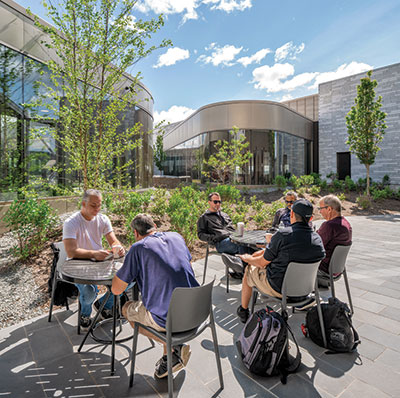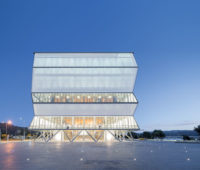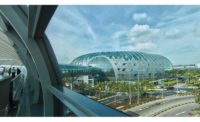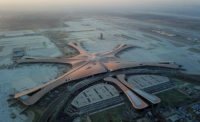Though lofty, daylight-splashed ticketing halls are common in airport architecture, Deborah Fennick and her partner Jonathan McCredie took a different approach in the redesign of the four-gate Elmira Corning Regional Airport in upstate New York. They focused instead on the most anxiety-provoking aspect of flying: the security-screening checkpoint, often buried in the terminal if not an afterthought altogether.
Additional Content:
Jump to credits & specifications
The $61.5 million expansion was driven primarily to accommodate larger aircraft—and the traffic they generate—used by ultra-low-fare carriers that are growing in non-metropolitan markets. Central to the stress-relieving approach taken by Boston-based Fennick McCredie Architecture is an outdoor green space that separates the steel-framed landside ticketing and baggage pavilion—which they gut-renovated—from the larger, new replacement air-side concourse. The 18,700-square-foot garden, designed by landscape architects Hargreaves Associates, should quickly grow into a tiny forest.
A wall of glass beyond the ticketing area draws the eye to this outdoor space, and a rounded corner signals the presence of a gently sloped, glass-walled ramp that curves its way through the garden, accommodating queueing for security as well as the checkpoint itself.
This “walk through the woods,” as McCredie put it on a recent visit, is a vast improvement over the usual grim march back and forth through a maze of switchbacking tensile barriers—a screening prelude that seems designed to amplify stress over whether the agent will insist on a body search, the baby will start to scream, or the plane will be missed. Travelers can also access the outdoor area—to hang out at café tables or take a stroll. One side of the garden is reserved for people who have not been screened; separated by the glass-walled ramp, the other side is open only to those who have passed through security.
Along the air-side gate concourse, curved glass walls round the corners of biomorphic lounges that project into the garden. In contrast to the usual rigid rows of departure seating, casually arranged couches and movable chairs invite passengers to relax. Gates are visible from these lounges, further allaying anxiety about missing planes. There are gate-side seats as well, but the view across the airfield is impeded by jetways and other servicing paraphernalia because, as is typical of small airports, the building is a single level and sits low to the ground.

Even with staged construction, to keep the airport open, the project was completed just 26 months from the time Fennick McCredie was awarded the design in September 2016. Both McCredie and the New York State Department of Transportation (DOT) credit Governor Andrew Cuomo, who has made speeding major capital projects to completion a priority (including the multibillion-dollar reconstruction of New York’s LaGuardia Airport, which also is moving quickly). “The governor’s office strove to expedite every aspect of the project,” says Walid Albert, DOT’s chief engineer. “We completed reviews quickly. We didn’t let anything sit in an in-basket if someone was not around.” Adds McCredie, “The governor’s office was very hands-on, down to the paint colors. They did not second-guess or go back to first principles, which was really helpful for the execution. No one slept much.”
Anyone can appreciate Fennick McCredie’s close attention to the experience of moving from curb to plane, given the prevailing view that cargo is often treated better than passengers in today’s swarming airports and on cramped planes. McCredie, whose 50-person office specializes in aviation projects, says security enhancements since 9/11 have taken airport architecture from being “a celebration of flight to focusing entirely on the efficient processing of passengers.” It is the firm’s goal to reverse this trend through a focus on alleviating the stresses endemic to air travel today.
It’s especially important to bring a measure of calm and dignity to smaller markets, he says, because many customers—especially families and seniors—who don’t fly much, are intimidated by airports. These travelers also tend to be price sensitive, which has brought ultra-low-fare airlines to places like Elmira Corning. Because these companies can afford to serve these locations only if they use bigger, fuel-efficient planes like the Boeing 737 and Airbus A320, the airport had to grow from 55,000 square feet to 88,000 in part to accommodate them. Traffic boomed to 278,000 passengers in 2018, an 11 percent increase in one year. Modest additional growth is expected, but the greater impact on the facility design was allowing for the big-plane peaks, which drove the addition of jet bridges and the enlargement of the departure lounges and screening area.
Airports the size of Elmira Corning never used to see planes with more than 60 seats. Responding to the new economics of aviation as well as security requirements is key to successful design. “These are among the biggest changes in airline travel,” says McCredie. “Small airports have to catch up.”
Back to Airports of the Future
CreditsArchitect: Fennick McCredie Architecture, Ltd., 70 Franklin Street, Boston MA 02110, 617.350.7900, www.FMarchitecture.com
Personnel in architect's firm who should receive special credit: Jonathan McCredie AIA Principal, Deborah Fennick AIA Principal
Interior designer: Fennick McCredie Architecture
Engineers: Civil: McFarland Johnson Mechanical: McFarland Johnson Electrical: McFarland Johnson Plumbing: McFarland Johnson Fire Protection: McFarland Johnson Structural: McFarland Johnson
Consultants: Landscape: Hargreaves Jones Landscape Architecture DPC Lighting: Ripman Lighting Consultants Acoustical: Acentech Audio/Visual: Acentech Envelope: Simpson Gumpertz & Heger, Inc., P.C. Baggage Handling: BNP Associates, Inc. Signage: STV, Inc. Food Service: L2M Foodservice Design Group Code: Code Red Consultants
Construction Manager: Welliver
General contractor: Streeter Associates, Inc.
Electrical contractor: John Mills Electric, Inc.
Mechanical contractor: Piccirilli-Slavik & Vincent Plumbing & Heating, Inc
Fire Protection contractor: Frey & Campbell, Inc.
Photographer: William Horne, horne visual media |
SpecificationsExterior Cladding Masonry: Lake Placid Blue Granite, Sierra White Granite: Coldspring Rainscreen system: Knight wall systems MFI system Metal MCM liner panel: Alucobond PE 4mm Expanded metal mesh panel: McNichols ½” #.081 AL-3003 Flush metal wall panels: Pac-Clad Flush Panel EIFS: Stolit Lotusan 1.0 Air and Vapor barrier: Carlisle Coatings and Waterproofing 705FR-A Fluid applied waterproofing: Kemper Kemperol 2K-Pur Curtain wall: Kawneer 1600 Wall System 1, System 2
Roofing Elastomeric: Sarnafil S327 Energysmart 60mil, white Metal: Pac-Clad Snap-Clad 16” aluminum
Windows Metal frame: EFCO Series 403
Glazing Convex and Concave Glass: Guardian Flat Glass: Viracon Skylights: Wasco
Doors Hollow metal doors: Curries Coiling Drapery: Cascade architectural Fabricoil Overhead coiling doors, back-of-house: Overhead Door Corporation Overhead coiling doors, public: Cornell with GKD Fabrics Lago mesh High-speed coiling door: Horman Speed-Master 1600 L Accordion folding fire doors: Won-Door Fireguard MFWII All Glass entrances: CR Laurence Revolving entrance doors: Assa Abloy Besam RD3 Breach control system: Kaba Orthos PIL-MO2
Hardware Locksets: Schlage L9000 Closers: Dorma BTS80, Sargent 281 Exit devices: Von Duprin Pulls: Rockwood RM3300, 112, Security devices: AMAG Technology Symmetry
Interior Finishes Acoustical ceilings: USG, Rockfon, Tectum, Suspension grid: USG Open Mesh Ceiling: Carritec Acoustical plaster ceilings: SonaKrete Cabinetwork and custom woodwork: n/a Paints and stains: Sherwin Williams Wall coverings: Filzfelt Metal wall paneling: Carritec Plastic laminate: Formica Solid surfacing: Corian Wall tile: Johnson Tiles Floor tile: American Olean Resilient flooring: Armstrong Carpet: Interface, Mohawk Terrazzo: Terroxy Resinous Flooring: Sherwin Williams
Furnishings Tandem Seating: Herman Miller Chairs: Geiger, Herman Miller Couches: Keilhauer Ottomans: OFS Sectional: Herman Miller Tables: Nucraft, Keilhauer, JSI, Magnuson Stools: Keilhauer, JSI Upholstery: Luum, Pallas, Momentum, HBF Lectern: Nucraft
Lighting Downlights: Forum, ALW, Lightolier, A-light, Electrix, Forum Inc, Tivoli, Insight Lighting, Pinnacle, MP Lighting, Finelite Exterior: Hadco, Gardco
Plumbing Faucets: Moen, Sloan Toilets: American Standard Flushometers: Sloan Urinal: American Standard |












Post a comment to this article
Report Abusive Comment